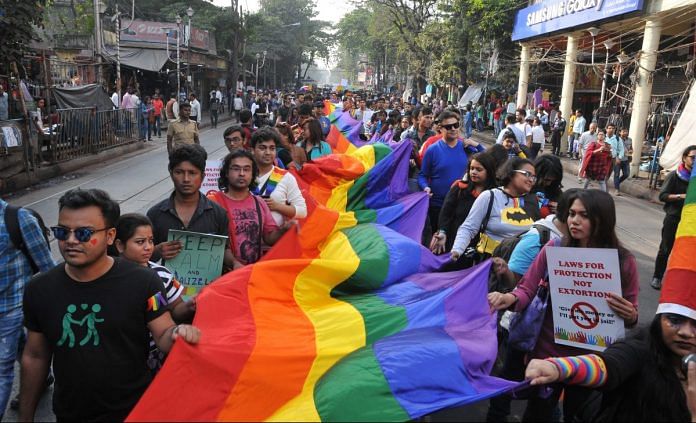The Supreme Court’s decision on Section 377 deserves careful unpacking, but it is noteworthy in at least four respects.
The Supreme Court’s decision to read down Section 377 of the Indian Penal Code has been long overdue. It is nothing short of a scandal that the Indian law, until a few hours ago, criminalised sexual relations between consenting adults. The history of its recent past is well-known. In 2013, the Supreme Court upheld Section 377, overturning a Delhi High Court verdict that had declared it unconstitutional. The Court’s 2013 verdict was called into question by subsequent developments, especially a 2014 decision that recognised the status of transgender individuals as equal citizens and a 2017 decision that acknowledged the right to privacy. Both judgments raised doubts over the continuing validity of Section 377, the matter was referred to a constitutional bench, and the criminalisation of the LGBTQ community is now, finally, a matter of the past.
The Court’s decision deserves careful unpacking, but it is noteworthy in at least four respects. First, the verdict scrutinised the standard that must exist for any discrimination to count as valid. States are, of course, permitted to discriminate among their citizens, and the central question for equality law is what counts as valid and invalid discrimination. One of many appalling features of the 2013 verdict was the test that it adopted to assess discrimination-based claims. The 2013 decision had declared that Section 377 was valid because those “who indulge in carnal intercourse in the ordinary course and those who indulge in carnal intercourse against the order of nature constitute different classes”.
Also read: I set my alarm at 5:30 am in UK to hear Section 377 verdict – Ritu Dalmia
This claim was made rubbish by the equality guarantee because it failed to ask whether the categories involved are intelligible and defensible ones. Under this standard, as I have suggested elsewhere, a law that prohibits blue-eyed children from receiving an education will be valid, because blue-eyed children can be distinguished from other children. The individual opinions in the new decision adopt slightly different tracks on this matter: While Chief Justice Dipak Misra and Justice Rohinton Nariman carefully inquired into whether the distinctions imposed are valid or arbitrary, and how they relate to the overall objective of the impugned measure, Justice D.Y. Chandrachud appeared to suggest that the Indian equality law may well require even more wholesale revising. But all judges agree on the need for serious scrutiny of imposed distinctions. Distinctions cannot be indefensible, the distinctions in Section 377 were as indefensible as it gets.
Second, Justice Chandrachud’s opinion on the penal character of the challenged law has much potential for future cases. One feature of Indian law over time has been its increasing criminalisation. Penal provisions are now routinely part of new statutes. Yet, as we have seen in the Supreme Court’s upholding of criminal defamation, the court rarely asks as to when the state is empowered to not only regulate an activity but, impose criminal sanctions. It is worth watching whether Justice Chandrachud’s observation, that crimes must be based on an element of “larger public interest”, becomes a tool to limit the state’s power to criminalise.
Also read: Section 377 verdict – Is political class passing the buck of simple decisions to courts?
Third, the Court vehemently rejected one of the most troubling aspects of the 2013 verdict, namely the idea that fundamental rights rest on the numerical strength of the claimants. The 2013 decision had appealed to the fact that “a minuscule fraction of the country’s population constitutes lesbians, gays, bisexuals or transgenders”. The new verdict rightly noted the irrelevance of numbers to the question of rights. Chief Justice Misra rightly referred to this logic as “perverse”. Numbers were, in such matters, “meaningless”. Fundamental rights rested on the status of someone as an individual. They had no relationship to the number of individuals that held that status. Indeed, the entire point of rights is that they were immune to the vagaries of numerical support.
Finally, the court underlined the importance of the public and private distinction, not in a trivial sense as is sometimes articulated, but in the sense that autonomy demands domains of private judgment and choice. The judgment is thoughtful and sensitive to the fears and pressures, the tensions and anxieties that arise from the lack of public respect for private choice. It is the domain of the individual, a domain free from both the state and society that autonomy must ultimately protect. It remains to be seen, however, how consistently and courageously the court will apply this principle – whether it will use it to analyse aspects of our religious laws and some features of our reservation schemes where the political stakes are higher.
Also read: Section 377 verdict: Can we start calling the CJI the CEO of India?
As we celebrate this verdict in unambiguous terms, we should file for a later day a conversation on the process. The 2013 verdict resulted in curative appeals, the court then admitted a fresh appeal on the matter, and it seems that both appeals were clubbed together. In the days ahead, the court needs to make clear what the practices for curatives and fresh appeals might be. Can, for example, a curative be filed on this new judgment given that a fresh appeal was filed? We have seen with public interest litigation, now some decades after it was introduced, how inattention to matters of procedures can create all kinds of pathologies. There is much that the court needs to settle and make clear. For now, however, it has earned a moment of rest.
Madhav Khosla, co-editor of the Oxford Handbook of the Indian Constitution, is a junior fellow at the Harvard Society of Fellows. His Twitter handle is @M_Khosla




Stupid butthurt Indian journalists…
Very nonprofessional Hindu based propaganda
I smell jealous Hinduuus